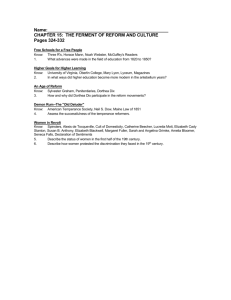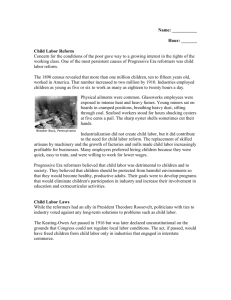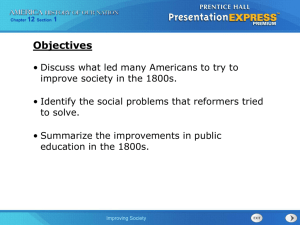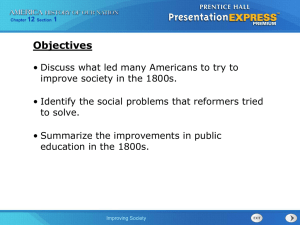Presentation
advertisement
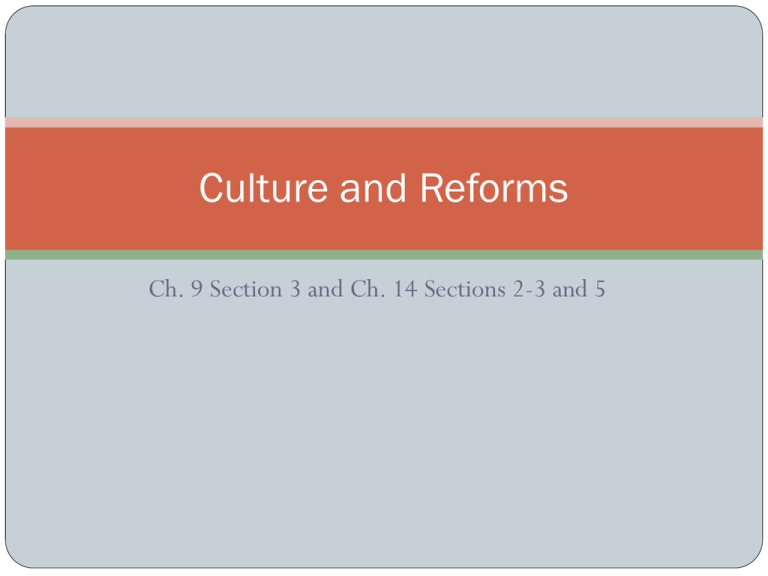
Culture and Reforms Ch. 9 Section 3 and Ch. 14 Sections 2-3 and 5 American Culture Ch 9 Sec 3: The Big Idea As the United States grew, developments in many cultural areas contributed to the creation of a new American identity. Main Idea 1: American writers created a new style of literature. Washington Irving Wrote about American history Used satire to warn that Americans should learn from the past and be cautious about the future Combined European influences with American settings and characters James Fenimore Cooper Focused on American characters and society Wrote stories about the western frontier and Native Americans Popularized historical fiction Main Idea 2: A new style of art showcased the beauty of America and its people. Early American artists had painted mainly portraits, but the new style of art involved painting landscapes that showed the history of America and the beauty of the land. Hudson River School Emerged in 1830s Founded by landscape painter Thomas Cole Created paintings that reflected national pride and beauty of American landscape Art in the 1840s The style of art began to change in the 1840s. Artists tried to combine images of the American landscape and scenes of people’s daily lives. Fur Traders Descending the Missouri, by George Caleb Bingham, is an important example of this style. Main Idea 3: American ideals influenced other aspects of culture, including religion and music. Religious revivalism swept the United States in the early and mid-1800s. Spirituals—songs based on text from the Bible—became popular in both African American and white folk-music traditions. Popular folk music reflected the unique views of the growing nation and rising nationalism. Main Idea 4: Architecture and education were affected by cultural ideals. American architects modeled buildings after the style of ancient Greece and Rome. Admired classical civilizations for their democratic and republican ideals. Early American political leaders believed an educated populace was needed for democracy. The idea of state-funded public schools gained support. Massachusetts created state board of education in 1837, and other states followed. American Arts Ch 14 Sec 2 The Big Idea New movements in art and literature influenced many Americans in the early 1800s. Main Idea 1: Transcendentalists and utopian communities withdrew from American society. Transcendentalism was the belief that people could transcend, or rise above, material things. Important transcendentalists included Ralph Waldo Emerson, Margaret Fuller, and Henry David Thoreau. Some formed a community at Brook Farm, Massachusetts, in the 1840s. It was one of many experiments in utopian communities, places where people tried to form a perfect society. In reality, most members did not work together well and the communities did not last long. Main Idea 2: American Romantic painters and writers made important contributions to art and literature. Ideas about simple life and nature inspired painters and writers. Some joined the Romantic movement that had begun in Europe. Romanticism involved an interest in nature, emphasis on individual expression, and rejection of many established rules. Painters and writers felt that each person brings a unique view to the world. They believed in using emotion to guide their creativity. Art of the Romantic Movement Some Romantic artists, like Thomas Cole, painted the American landscape. Their works celebrated the beauty and wonder of nature in the United States. Their images contrasted with the huge cities and corruption of nature that many Americans saw as typical of Europe. American Romantic Writers Many women writers, including Ann Sophia Stephens, wrote historical fiction that was popular in the mid-1800s. Nathaniel Hawthorne wrote The Scarlet Letter, one of the great classics of Romantic literature. Herman Melville wrote Moby Dick, a novel about the sea that many people believe is the finest American novel ever written. American Romantic authors also wrote poetry, including Edgar Allen Poe, who became famous for “The Raven.” Other gifted poets included Emily Dickinson, Henry Wadsworth Longfellow, and Walt Whitman. Reforming Society Ch 14 Sec 3- The Big Idea Reform movements in the early 1800s affected religion, education, and society. Main Idea 1: The Second Great Awakening sparked interest in religion. Second Great Awakening: Christian renewal movement during 1790s and early 1800s. Swept upstate New York and frontier regions and later spread to New England and the South. Charles Grandison Finney was an important leader. Believed each person was responsible for own salvation. Should prove faith by doing good works. These ideas angered some traditional ministers, like Boston’s Lyman Beecher. Church membership increased significantly during this period. Renewed religious faith of people throughout America. Main Idea 2: Social reformers began to speak out about temperance and prison reform. Reform Movements Renewed religious faith led to movements to reform society. Urban growth had caused problems. Members of the middle class, especially women, led the efforts. They tackled alcohol abuse, prison and education reform, and slavery. Reform Movements Temperance Movement • Many Americans thought alcohol abuse caused family violence, poverty, and criminal behavior. • Temperance Movement was effort to have people stop drinking hard liquor • Message spread by American Temperance Society and American Temperance Union Prison Reform • Dorothea Dix led movement to reform prison system • Reformers worked to remove the mentally ill, runaway children, and orphans from prisons. • Governments responded by building mental hospitals, reform schools for children, and houses of correction that provided education for prisoners. Main Idea 3: Improvements in education reform affected many segments of the population. Education in the Early 1800s • Few teachers were trained, and schoolhouses were small and had only one room for all students. • Social background and wealth affected education quality. Common-School Movement • Common-School Movement reformers wanted all children taught in a common place regardless of wealth. • Horace Mann was a leader in this movement. – Became Massachusetts’s first secretary of education. – Convinced the state to double the school budget, raise teachers’ salaries, lengthen the school year, and begin the first school for teacher training. More Educational Reforms Education reform created opportunities for women. Catharine Beecher started an all-women academy. Women’s colleges opened, the first in 1821. Education reform also helped people with special needs. Thomas Gallaudet opened a school for the hearing impaired in 1817; a school for the blind opened in 1831. Main Idea 4: Northern African American communities became involved in reform efforts. Free African Americans usually lived in segregated, or separate, communities in the North. The Free African Religious Society, founded by former slave Richard Allen, became a model for other groups that worked for racial equality and education for blacks. Many influential African Americans pushed for the creation of schools for black Americans. New York, Philadelphia, and Boston opened elementary schools for African American children. Few colleges would accept African Americans, however. In the South, laws barred most enslaved people from receiving any education. Women’s Rights The Big Idea Reformers sought to improve women’s rights in American society. Main Ideas • Influenced by the abolition movement, many women struggled to gain equal rights for themselves. • Calls for women’s rights met opposition from men and women. • The Seneca Falls Convention launched the first organized women’s rights movement in the United States. Main Idea 1: Influenced by the abolition movement, many women struggled to gain equal rights for themselves. Fighting for the rights of African Americans led many women abolitionists to fight for their own rights. They found that they had to defend their right to speak in public. Critics did not want women to leave traditional female roles. Early Women Reformers Grimké Sisters Sojourner Truth • Sarah Grimké wrote pamphlet in 1838 arguing for equal rights for women. • Powerful supporter of both abolition and women’s rights. • Angelina Grimké refused to promise to obey her husband during their marriage ceremony. • Born into slavery in 1797. • Transcendentalist Margaret Fuller wrote Woman in the Nineteenth Century (1845), stressing importance of individualism to people, especially to women. • Took name Sojourner Truth because she felt her mission was to be a sojourner, or traveler, and spread the truth. • Never learned to read or write, but impressed people with her speeches. Main Idea 2: Calls for women’s rights met opposition from men and women. The Movement Grows • Women’s concerns became a national issue when women took a more active and leading role in reform and abolition. • Some men also began to fight for women’s rights. Opposition to Women’s Rights • Some women believed they did not need new rights. • Some people thought that women lacked the physical or mental strength to survive without men’s protection. Main Idea 3: The Seneca Falls Convention launched the first organized women’s rights movement in the United States. Elizabeth Cady Stanton and Lucretia Mott organized the Seneca Falls Convention. The convention was the first public meeting about women’s rights held in the United States. The convention opened on July 19, 1848, in Seneca Falls, New York. Organizers wrote a Declaration of Sentiments. Declaration of Sentiments Document detailed beliefs about social injustice toward women Used Declaration of Independence as basis for language Authors included 18 charges against men Signed by some 100 people About 240 people attended Seneca Falls Convention Men included such reformers as Frederick Douglass. Many other reformers who worked in the temperance and abolitionist movements were present. Women’s Rights Leaders Lucy Stone • Well-known spokesperson for Anti-Slavery Society. • Was a gifted speaker who stirred the nation on women’s rights. Susan B. Anthony Elizabeth Cady Stanton • Turned fight for women’s rights into a political movement. • Wrote many documents and speeches of the movement. • Argued for equal pay for equal work—no woman could be free without a “purse of her own.” • Founder and leader of National Woman Suffrage Association.
